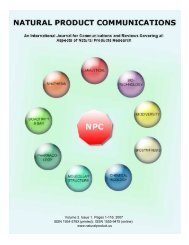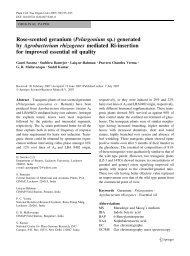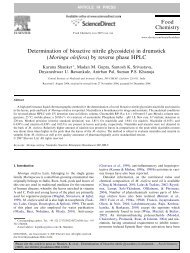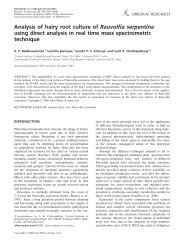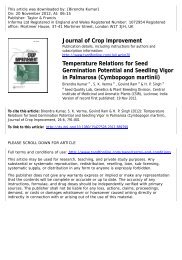Rai A, Smitha SS, Singh AK, Shanker K, Nagegowda ... - CIMAP Staff
Rai A, Smitha SS, Singh AK, Shanker K, Nagegowda ... - CIMAP Staff
Rai A, Smitha SS, Singh AK, Shanker K, Nagegowda ... - CIMAP Staff
- No tags were found...
You also want an ePaper? Increase the reach of your titles
YUMPU automatically turns print PDFs into web optimized ePapers that Google loves.
Page 8 of 20<strong>Rai</strong> et al. • C. roseus Geranyl Diphosphate SynthasesFigure 6. Purification, Enzyme Activity, and In Vitro Product Analysisof Homomeric CrGPPS.(A) SDS–PAGE analysis of purified recombinant CrGPPS from E. coli.(B) Enzyme activity of purified recombinant CrGPPS assayed with[1- 3 H]-IPP and DMAPP.(C) TLC analysis of reaction products from in vitro assays of purifiedCrGPPS in the presence of IPP and DMAPP.(D) TLC analysis of products from in vitro assays of purified CrGPPSin the presence (+) or absence (–) of GPP/FPP with IPP. The productformed is indicated by a dashed box, while other spots are unreactedsubstrates. Products were hydrolyzed enzymatically, and the resultingalcohols were analyzed by TLC. The products were confirmed by comparingthe spots with authentic standards G (geranol), F (farnesol), andGG (geranylgeranol). The boiled protein is used as negative control. E,enzyme; B, boiled enzyme.monoterpene formation, but at the expense of primarymetabolism (Orlova et al., 2009). It was suggested that thein vivo formation of heteromeric GPPS complex betweenthe introduced snapdragon GPPS.<strong>SS</strong>U and tobacco GGPPSsredirected the metabolic flux to GPP formation consequentlydepleting the GGPP pool needed for primary metabolism (Orlovaet al., 2009). Thus, efforts through metabolic engineering ofdual G(G)PP synthase could increase both GPP and GGPP poolwithout affecting the primary metabolism in C. roseus.To characterize the product formation by the heteromericCrGPPS.<strong>SS</strong>U/CrGPPS.LSU complex, the co-purified proteinswere used for prenyltransferase assays, which showed GPP asthe exclusive product (Figure 4C). This is consistent with earlierreports on heteromeric GPPS from A. majus (Tholl et al., 2004)and in contrast to observations with heteromeric GPPS fromH. lupulus and M. piperita that produced both GPP and GGPPand trace amounts of FPP (Wang and Dixon, 2009; Changet al., 2010). These results indicated that catalytically activeGPPS in C. roseus is present as a heteromer, which consists ofinactive CrGPPS.<strong>SS</strong>U as a small subunit and an active bifunctionalG(G)PPS as a large subunit. The interaction betweenCrGPPS.LSU and CrGPPS.<strong>SS</strong>U modified the chain length specificityof CrGPPS.LSU resulting in the exclusive production ofGPP from IPP and DMAPP (Figure 4C). It has been shown inthe structure of heteromeric GPPS from M. piperita that <strong>SS</strong>Urestricts the connection between active site cavity and elongationcavity thereby limiting the catalytic reaction to go beyondC 10 -GPP (Chang et al., 2010). Similarly, in C. roseus, it is possiblethat the interaction of CrGPPS.<strong>SS</strong>U alters the catalytic siteof CrGPPS.LSU in their subunit architecture and confined theenzyme specificity to the formation of only GPP (Figure 4C).Moreover, the complex formation suggests that CrGPPS.<strong>SS</strong>Uhas a strong affinity to CrGPPS.LSU and could control CrGPPS.LSU homomerization. Our results show that CrGPPS.LSU perse is a functional GGPPS, which may be involved in primarymetabolism, but to some extent could also contribute to secondarymetabolism with its ability to release a substantialportion of the intermediate GPP, similarly to PaIDS1 (Schmidtet al., 2010). However, formation of a heteromer with CrGPPS.<strong>SS</strong>U resulting in highly efficient GPPS could contribute to themajor redirection of flux to secondary metabolism.Heterologous Expression and FunctionalCharacterization of Homomeric CrGPPSFor functional characterization of homomeric CrGPPS,the open reading frame was cloned into expression vectorpET28a having an N-terminal (His) 6 -tag. The cloned constructwas transformed into E. coli and the recombinant CrGPPSwas expressed as a (His) 6 -tag fusion protein. The full-lengthrecombinant CrGPPS protein was completely insoluble (datanot shown). A truncated version of CrGPPS starting fromsecond methionine (Met 100 –CrGPPS), and containing a (His) 6 -tag, was expressed in E. coli. The truncation was based onearlier reports of A. grandis GPPS and LeGPS where truncationdid not affect the catalytic activity and product profile(Burke and Croteau, 2002a; van Schie et al., 2007). The assaywith purified recombinant CrGPPS proteins using [1- 3 H]-IPPand DMAPP as substrates showed prenyltransferase activity(Figure 6A and 6B). While the purified recombinant CrGPPSproduced GPP as the sole product with IPP and DMAPP assubstrates (Figure 6C), it produced trace amounts of GGPP inthe presence of either GPP or FPP along with IPP (Figure 6D).Both CrGPPS.LSU and CrGPPS showed preference for Mg 2+over Mn 2+ and K + as cofactor similarly to other prenyltransferases(Supplemental Figure 1). The formation of only GPPby CrGPPS with IPP and DMAPP as substrates is in contrastto other homomeric GPPSs of the same clade representedby LeGPS, QrIDS1, and PaIDS3, which produced substantialDownloaded from http://mplant.oxfordjournals.org/ at Central Inst. Of Medicinal & Aromatic Plants (Cimap) on July 17, 2013




